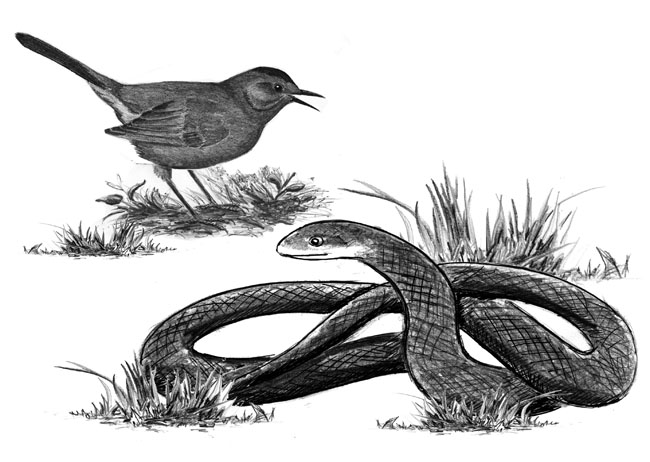
Dear Bird Folks,
I assume you have written about this before, but I’ve been seeing lots of catbirds lately and would like to know more about them. Would you mind writing about catbirds? Thanks.
– Ron, Eastham, MA
No problem, Ron,
You don’t have to ask me twice to write about catbirds. Next to chickadees, they are my favorite birds and I’ll chat about them any chance I get. Many of my customers (mostly women) think cardinals and goldfinches are the ultimate feeder birds, but I’d rather watch a catbird any day. The instant a catbird lands on my feeder I put down whatever paperwork I’m dealing with and turn my focus to the bird. It’s hard to explain how such plainly colored birds can be so interesting, but they are really fun to watch. (BTW: Don’t write me letters about my crack about women being the biggest fans of cardinals and goldfinches. It’s not sexist; it’s reality.)
If Atlantic City ever held a bird beauty contest, the catbird wouldn’t even make it past the first audition. While some birds have the plumages of rock stars, the gray and black catbirds look less like rock stars and more like funeral parlor attendants. But what catbirds lack in color, they more than make up for in personality. They are inquisitive, friendly and always give the impression that they are up to something. Try looking a goldfinch in the eye and it will quickly fly away and chirp its nervous, “Oh, dear. Oh, dear” call as it goes. (Yes, “Oh, dear” is what they say. Listen next time and you’ll hear it, really.) On the other hand, if you make eye contact with a catbird, it will stare you down. They’re up to something. I just know it.
Most catbirds arrive in May, after spending the winter in Central America or along the southern U.S. coast. As a gluttonous merchant, I hail the arrival of the hummingbirds and orioles. (For some reason no one can ever remember where they’ve put their feeders from the year before, so they come to me to buy new ones.) But I really look forward to hearing my first catbird of the spring. In addition to their signature “meow” call, catbirds sing an endless series of squeaking and chatting phrases. Their songs remind me of the sound produced by those red twisting Audubon birdcalls we all had when we were kids. (Well, at least kids like me had them.) From early May until late summer (when the birds quiet down for their annual molt), just about every woodlot or yard on the Cape is filled with the cheery songs of Gray Catbirds.
Folks sometimes show me an empty eggshell that they have found. Often these shells are bright blue and they proudly assume the egg belongs to a robin. While it is true that robins’ eggs are indeed “robin’s egg blue,” their eggs are pale compared to the deep, blue-green eggs of a catbird. The people are often disappointed when I inform them that they have found a catbird’s egg. So I proceed to tell them how cool catbirds are, including a story I just heard this spring. It seems Katie, a local landscaper, had cut down a big rhododendron bush and was just about to haul it away, when she noticed that hidden inside the bush was a nest containing four blue eggs. Katie quickly tied the bush back in place and hoped for the best. A few minutes later a dedicated and undeterred mother catbird returned to her slightly relocated nest and continued incubating her eggs. And the next day, the baby catbirds started hatching. Usually when I finish one of these stories people smile and walk away. I’m never sure if I’ve changed their mind about catbirds or if they just want to get away from me.
In addition to the calls and songs I mentioned earlier, catbirds produce a totally different sound when they are upset. Yesterday, while I was enjoying my afternoon sarsaparilla, I could hear a steady flow of “k-wut” sounds coming from the backyard. I walked out onto my patio and didn’t see a single creature: no birds, chipmunks or even squirrels. What was up? Hawk? Fox? The Terminator? Then in the corner of the patio I saw the problem, and it was worse than the Terminator. It was a black racer, Cape Cod’s largest snake. Typically black racers are five to six feet long, but this one was easily eighty-seven feet or maybe longer (in my mind). This is the reason why all of the creatures had left my yard…well, all of them except the catbird. This brave little two-ounce bird went right after the fire-breathing serpent, scolding and continuously flying at it, and even landing on its back. Eventually, the black racer took the hint and slithered off to the yard next-door, where it will hopefully ingest my neighbor’s yappy little dog.
Catbirds aren’t usually thought of as feeder birds, but in my yard they readily come to a tray of raisins and to the birdbath. They love the birdbath. Many other folks report that these birds are also attracted to the same grape jelly and oranges that the orioles like. I guess catbirds aren’t real fussy and seem to like just about everything…except, of course, snakes.
I’m glad you like catbirds, Ron. They are fun birds to watch. Just remember, if you are doing yard work, check before you cut down anything. Birds are nesting everywhere this time of year. Better yet, put off the yard work until the fall, when the nesting season is over. That’s what I do. Actually, I’ve put off doing any yard work at all for the past twenty-two years in a row. It’s better to be safe than sorry.